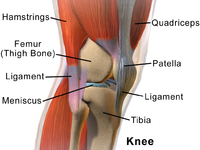
Photo from wikipedia
The observed dynamic knee valgus and the limited dynamic balance described in the literature are modifiable risk factors for injuries in athletes. Therefore, identification and appropriate prevention are crucial in… Click to show full abstract
The observed dynamic knee valgus and the limited dynamic balance described in the literature are modifiable risk factors for injuries in athletes. Therefore, identification and appropriate prevention are crucial in managing the development of young athletes. The aim of the study was to assess the effectiveness of three exercises strengthening the muscles: gluteal medius, popliteal and tibialis posterior to reduce dynamic knee valgus and improve the dynamic balance of the lower limbs in young football players with poor knee control. A total of 134 footballers were assessed for eligibility, and finally 45 participants (age 12–15) met the inclusion criteria. Participants were assessed with 2D video kinematic analysis during single-leg squats to assess the knee valgus angles and the dynamic balance (Y-Balance Test). No significant interactions between groups (Control and Exercise) and time (baseline and after 6 week) were noted for dynamic valgus for the left and right knee (p > 0.05). For the dynamic balance, there were statistically significant results, but not clinically relevant for anterior, posteromedial, and composite direction for the right lower limbs and for the anterior direction for left lower limbs in the exercise group. However, there were no significant differences (p > 0.05) in all of the YBT scores for both lower limbs between groups. This study demonstrated that there were no statistically significant differences in dynamic knee valgus angles and dynamic balance values after 6 weeks of exercise program in young footballers with poor knee control. Future randomized trials should focus on more comprehensive exercises, where possible using biofeedback methods to improve knee kinematics.
Journal Title: Healthcare
Year Published: 2021
Link to full text (if available)
Share on Social Media: Sign Up to like & get
recommendations!